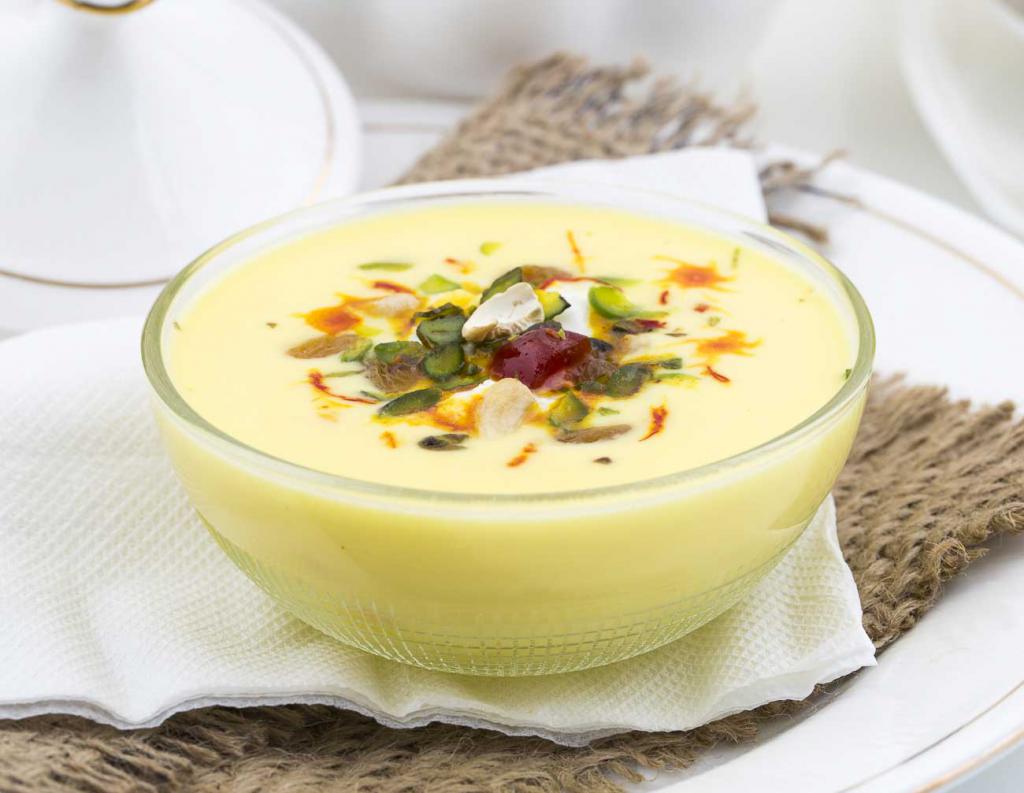طرز تهیه (آموزش پخت) فرنی در خانه / برای 4 نفر + 3 دستور پخت متفاوت
 فرنی (Ferni) که در برخی قسمتهای شبهقاره هند مشابه زبان فارسی phirni نامیده میشود غذایی است که با آرد برنج و شیر و سایر افزودنیها پخته میشود و معمولا همراه غذای اصلی یا به عنوان دسر مصرف میشود.
فرنی (Ferni) که در برخی قسمتهای شبهقاره هند مشابه زبان فارسی phirni نامیده میشود غذایی است که با آرد برنج و شیر و سایر افزودنیها پخته میشود و معمولا همراه غذای اصلی یا به عنوان دسر مصرف میشود.طرز تهیه فرنی
آرد برنج را در ۳ پیمانه آب حل میکنند و از صافی میگذرانند. سپس ۱۵–۲۰ دقیقه روی آتش ملایم میپزند. شیر را اضافه میکنند و هم میزنند و ۱۰ دقیقه دیگر میپزند. شکر (در صورتیکه با مربا یا عسل یا شیره انگور میل نشود) و هل و گلاب را در مایهٔ فرنی میریزند و پس از دوسه جوش از روی آتش برمیدارند. فرنی را بدون شکر نیز درست میکنند و با شیرهٔ انگور یا عسل ویا مربای گل یا میوه میخورند.

فرنی با نشاسته
علاوه بر فرنی با آرد برنج، فرنی با نشاسته نیز تهیه میشود. در این دستورالعمل، نشاسته را داخل اندکی آب سرد حل کرده و سپس شیر و شکر (در صورتیکه با مربا یا عسل یا شیره انگور میل نشود) را به آن اضافه میکنیم. مخلوط را روی حرارت دائم به هم میزنیم تا سفت شود. سایر دستور پخت همانند فرنی با آرد برنج است. میتوان فرنی را یه صورت کاکائویی و زعفرانی نیز سرو کرد. برای فرنی کاکائویی کافی است مقداری کاکائو به فرنی اضافه کرد؛ و برای نوع زعفرانی یک قاشق زعفران آب کرده به آن اضافه میکنیم.
دستور شماره یک
شیر ۲ لیوان
آرد برنج ۲ قاشق غذاخوری سرپر
شکر ۴ قاشق غذاخوری (در صورتی که فرنی را با مربا میل خواهید کرد از ریختن شکر خوداری کنید)
آب نصفِ استکان
گلاب ۱ قاشق غذاخوری
کاکائو ۱ قاشق مرباخوری برای تزیین در صورت تمایل
آرد برنج ۲ قاشق غذاخوری سرپر
شکر ۴ قاشق غذاخوری (در صورتی که فرنی را با مربا میل خواهید کرد از ریختن شکر خوداری کنید)
آب نصفِ استکان
گلاب ۱ قاشق غذاخوری
کاکائو ۱ قاشق مرباخوری برای تزیین در صورت تمایل
طرز تهیه:
ابتدا شیر سرد را با لیوانهای دسته دار که در تمامی خانهها یافت میشود در قابلمه مورد نظر بریزید. سپس آرد برنج و آب را اضافه کنید و کاملاً هم زنید تا آرد در شیر سرد حل شود روی حرارت گذاشته و مرتباً هم زنید اگر لحظاتی هم زدن را متوقف کنید، باعث میشود آرد برنج در شیر گلوله گلوله شود. پس مرتباً به هم زنید تا کمی غلیظ شود بعد از روی حرارت کنار گذاشته و شکر و گلاب را اضافه کنید. دوباره روی حرارت گذارید و هم زنید تا قوام لازم برای فرنی بدست آید فرنی را بایستی سریعاً در کاسههای کوچکی که از قبل آماده چیدهاید، بریزید دقت داشته باشید که در هنگام سرد شدن کمی سفت تر میشود پس وقتی از روی حرارت برمی دارید نه سفت و نه شل باشد.
روش تزئین فرنی:
برای تزئین فرنی کاکائو را در چند قطره آب حل کنید تا عصاره غلیظی بدست آید و با نوک قاشق یا قطره چکان روی فرنیهایی که در کاسهها کمی سرد شده و خود را گرفته، تزئین کنید.
دستور شماره دو
آرد برنج الک شده ۳ قاشق سوپخوری
شیر ۲ لیوان
گلاب ۲ قاشق سوپخوری
شکر ۴ یا ۵ قاشق سوپخوری (در صورتی که فرنی را با مربا میل خواهید کرد از ریختن شکر خوداری کنید)
شیر ۲ لیوان
گلاب ۲ قاشق سوپخوری
شکر ۴ یا ۵ قاشق سوپخوری (در صورتی که فرنی را با مربا میل خواهید کرد از ریختن شکر خوداری کنید)
طرز تهیه:
آرد برنج را پس از خیس کردن در آب سرد، به همراه شیر و گلاب و شکر روی شعله اجاق گاز قرار دهید و مرتب مواد را هم بزنید تا مایه به غلظت مورد نظر برسد. سپس آن را از روی شعله بردارید و در ظرف مورد نظر ریخته و با دارچین تزئین کنید.
نکته: اگر میخواهید فرنی را با شیره یا مربای گل یا هر ماده شیرین دیگری مانند اینها میل کنید، شکر را از مواد لازم حذف کنید.
دستور شماره سه
شیر یک کیلو
آرد برنج کاملاً نرم ۱۰۰ گرم
شکر ۱۵۰ گرم (در صورتی که فرنی را با مربا میل خواهید کرد از ریختن شکر خوداری کنید)
گلاب یک استکان
نمک کم
دارچین و پودر پسته برای تزیین به مقدار لازم
آرد برنج کاملاً نرم ۱۰۰ گرم
شکر ۱۵۰ گرم (در صورتی که فرنی را با مربا میل خواهید کرد از ریختن شکر خوداری کنید)
گلاب یک استکان
نمک کم
دارچین و پودر پسته برای تزیین به مقدار لازم
طرز تهیه فرنی:
در یک قابلمه آرد برنج، شکرو نمک را ریخته و شیر را کمکم به آن اضافه کنید و به هم بزنید تا آرد برنج در شیر حل شود. ظرف را روی حرارت ملایم قرار دهید و مرتب هم بزنید تا فرنی شما به جوش بیاید.
در این مرحله گلاب هم اضافه کرده و ظرف را روی صفحه شعله بخش کن قرار دهید و حرارت را ملایم کنید تا فرنی جا بیفتد. معمولاً بعد از جوش آمدن فرنی، ۱۰-۱۲ دقیقه روی حرارت بماند کافی است.
پس از آماده شدن فرنی، آن را در ظرف مورد نظر کشیده و پس از ۲-۳ دقیقه با پودر و دارچین روی فرنی را تزیین کنید.
Kheer or Firni is a pudding, originating from the Indian subcontinent, made by boiling milk and sugar with one of the following: rice, broken wheat, tapioca, vermicelli, or sweet corn. It is flavoured with cardamom, raisins, saffron, cashews, pistachios, almonds or other dry fruits and nuts. It is typically served during a meal or as a dessert.It also has many varieties which are not as thick as Kheer, they are known as meetha bhaat, payasam, payasa etc.
Regional variations
Kheer originated at the kitchens of imperial Muslim bawarchis of India and is an important sweet delicacy for Muslims of India especially during Eid or any other celebrations. The Muslims food culture later effected other Indians so much so that some dishes like kheer or its varieties are popularly prepared in Hindu festivals, temples, and all special occasions. The term kheer (used in North India) may derive from the Sanskrit word Ksheera (which means "milk") which was borrowed into Urdu. Other terms like Payasam or payesh (used in the Bengal region) are derived from the Sanskrit word Payasa or Payasam, which also means "milk". It is prepared using milk, rice, ghee, sugar/jaggery, and khoya but is less thicker then original kheer. Some also add a little bit of heavy cream for a richer taste. It is often garnished using almonds, cashews, raisins and pistachios. There is one more popular version of North Indian kheer, prepared during festivals and havan in Varanasi by using only milk, rice, ghee, sugar, cardamom, dried fruit, and kesar (saffron milk). It is an essential dish in many Hindu feasts and celebrations. While the dish is most often made with rice, it can also be made with other ingredients, such as vermicelli (semiya in South India, seviyan, seviyaan, sayviah, or other spellings) or tapioca (locally known as sabudana). In Kashmir, firni is made with semolina (suji), milk, saffron, sugar, dry fruits, etc.
Rice was known to the Romans, and possibly introduced to Europe as a food crop, dating as early as the 8th or 10th Century AD, and so the recipe for the popular English rice pudding is believed by some to be descended from kheer. Similar rice recipes (originally called potages) go back to some of the earliest written recipes in English history.
East Indian version
Payasam made from jaggery and rice is also a part of Prasadam served during temple festivals or occasions. Variations of payasam are also made from lentils. Another variation of payasam is made from rice ada and is referred to as prathaman. It is supposed to be the top dish in the Kerala Sadya.Mango and Wheat Kheer is the variation of the kheer.
The Odia version of rice kheer (known as Kheeri) and (Payas in Northern Odisha) likely originated in the city of Puri, in Odisha more than 2,000 years ago. Although original Kheer Payas originated as two separate dishes, they are increasingly considered by some to be similar but it is not. The Odia version has more fruirs and is little less thicker. Payas are cooked to this day within the temple precincts there wheres as Kheer is available in restaurants mostly during Ramadan. Every single day, hundreds of temple cooks work around 752 hearths in what is supposed to be the world"s largest kitchen to cook over 100 different dishes, including kheer, enough to feed at least 10,000 people.
Payas is also regarded as an auspicious food and generally associated with annaprashana (weaning ritual of an infant), as well as other festivals and birthday celebrations in an Odia household.
Although white sugar is commonly used, adding Gurh (jaggery) as a sweetener, is an interesting and extremely delicious variation prepared in Bengal and Odisha, especially during winter and spring when fresh gurh is available.
In Bengal, it is called payas or payesh. A traditional Bengali meal can be traced 2000 years old and it is one of important sweet dish payas followed by other sweets.
Payesh is also regarded as an auspicious food and generally associated with annaprashana (weaning ritual of an infant) and Janmatithi (birthday) in a Bengali household. It is called kheer in Bengali if milk is used in a significantly greater amount than rice. The people of West Bengal and Bangladesh prepare payesh with gurh, ketaki, glutinous rice, vermicelli, semolina and coconut milk, and the result is a stickier and creamier dessert.
In Assam, it is called payoxh and in addition to other dried fruits, cherries are added to give it a light delicate pink colour. Sometimes rice may be replaced with sago. It is one of the most significant desserts served in Assamese families and quite often a part of religious ceremonies.
In Bihar, it is called "Chawal ki Kheer". It is made with rice, full fat cream, milk, sugar, cardamom powder, an assortment of dried fruits, and saffron. Another version of this kheer, called Rasiya, is made with jaggery. Jaggery is used instead of sugar in the process. The jaggery version looks brown in color and has a mild, sweet taste.
South Indian version
The South Indian version, payasam or payasa (a Kannada term; Kannada: ಪಾಯಸ), is an integral part of traditional South Indian meals. South Indian payasam also makes extensive use of jaggery (Tamil: வெல்லம் vellam, Telugu: బెల్లం bellam, Kannada: ಬೆಲ್ಲ bella, Malayalam: ശർക്കര sharkkara) and coconut milk in place of sugar and milk. Vermicelli (semiya) is commonly used. The most common types of payasam in South India include milk payasam,sago/tapioca pearl payasam, Semiya (vermicelli) payasam, Paruppu payasam, Nei (clarified butter) payasam (also known as Aravana payasam), Carrot payasam, Wheat payasam, Wheat rava (wheat semolina) payasam, and Arisi Thengai (coconut and rice) payasam, which is a traditional Iyengar-style recipe. It is not exactly Kheer, since most of the process is same it is generalised as Kheer. Payasam is less thicker and it conains semiya/vermicelli which is not a content of original Kheer.
In a South Indian meal, payasam or payasa, is served first at any formal or auspicious occasion. Payasam is also served after rasam rice, while rice with buttermilk forms the last item of the meal. Payasam also forms an integral part of the Kerala feast (sadya), where it is served and relished from the flat banana leaf instead of cups. In Malayalee or Kerala cuisine, there are several different kinds of payasam that can be prepared from a wide variety of fruits and starch bases, an example being chakkapradhaman made from jackfruit pulp and adapradhaman made from flat ground rice.
The Hyderabadi version is called gil-e-firdaus. It is a thick kheer made with milk and bottle gourd. Gil-e-firdaus, literally translated, means "the clay of paradise".
Regional variations
Kheer originated at the kitchens of imperial Muslim bawarchis of India and is an important sweet delicacy for Muslims of India especially during Eid or any other celebrations. The Muslims food culture later effected other Indians so much so that some dishes like kheer or its varieties are popularly prepared in Hindu festivals, temples, and all special occasions. The term kheer (used in North India) may derive from the Sanskrit word Ksheera (which means "milk") which was borrowed into Urdu. Other terms like Payasam or payesh (used in the Bengal region) are derived from the Sanskrit word Payasa or Payasam, which also means "milk". It is prepared using milk, rice, ghee, sugar/jaggery, and khoya but is less thicker then original kheer. Some also add a little bit of heavy cream for a richer taste. It is often garnished using almonds, cashews, raisins and pistachios. There is one more popular version of North Indian kheer, prepared during festivals and havan in Varanasi by using only milk, rice, ghee, sugar, cardamom, dried fruit, and kesar (saffron milk). It is an essential dish in many Hindu feasts and celebrations. While the dish is most often made with rice, it can also be made with other ingredients, such as vermicelli (semiya in South India, seviyan, seviyaan, sayviah, or other spellings) or tapioca (locally known as sabudana). In Kashmir, firni is made with semolina (suji), milk, saffron, sugar, dry fruits, etc.
Rice was known to the Romans, and possibly introduced to Europe as a food crop, dating as early as the 8th or 10th Century AD, and so the recipe for the popular English rice pudding is believed by some to be descended from kheer. Similar rice recipes (originally called potages) go back to some of the earliest written recipes in English history.
East Indian version
Payasam made from jaggery and rice is also a part of Prasadam served during temple festivals or occasions. Variations of payasam are also made from lentils. Another variation of payasam is made from rice ada and is referred to as prathaman. It is supposed to be the top dish in the Kerala Sadya.Mango and Wheat Kheer is the variation of the kheer.
The Odia version of rice kheer (known as Kheeri) and (Payas in Northern Odisha) likely originated in the city of Puri, in Odisha more than 2,000 years ago. Although original Kheer Payas originated as two separate dishes, they are increasingly considered by some to be similar but it is not. The Odia version has more fruirs and is little less thicker. Payas are cooked to this day within the temple precincts there wheres as Kheer is available in restaurants mostly during Ramadan. Every single day, hundreds of temple cooks work around 752 hearths in what is supposed to be the world"s largest kitchen to cook over 100 different dishes, including kheer, enough to feed at least 10,000 people.
Payas is also regarded as an auspicious food and generally associated with annaprashana (weaning ritual of an infant), as well as other festivals and birthday celebrations in an Odia household.
Although white sugar is commonly used, adding Gurh (jaggery) as a sweetener, is an interesting and extremely delicious variation prepared in Bengal and Odisha, especially during winter and spring when fresh gurh is available.
In Bengal, it is called payas or payesh. A traditional Bengali meal can be traced 2000 years old and it is one of important sweet dish payas followed by other sweets.
Payesh is also regarded as an auspicious food and generally associated with annaprashana (weaning ritual of an infant) and Janmatithi (birthday) in a Bengali household. It is called kheer in Bengali if milk is used in a significantly greater amount than rice. The people of West Bengal and Bangladesh prepare payesh with gurh, ketaki, glutinous rice, vermicelli, semolina and coconut milk, and the result is a stickier and creamier dessert.
In Assam, it is called payoxh and in addition to other dried fruits, cherries are added to give it a light delicate pink colour. Sometimes rice may be replaced with sago. It is one of the most significant desserts served in Assamese families and quite often a part of religious ceremonies.
In Bihar, it is called "Chawal ki Kheer". It is made with rice, full fat cream, milk, sugar, cardamom powder, an assortment of dried fruits, and saffron. Another version of this kheer, called Rasiya, is made with jaggery. Jaggery is used instead of sugar in the process. The jaggery version looks brown in color and has a mild, sweet taste.
South Indian version
The South Indian version, payasam or payasa (a Kannada term; Kannada: ಪಾಯಸ), is an integral part of traditional South Indian meals. South Indian payasam also makes extensive use of jaggery (Tamil: வெல்லம் vellam, Telugu: బెల్లం bellam, Kannada: ಬೆಲ್ಲ bella, Malayalam: ശർക്കര sharkkara) and coconut milk in place of sugar and milk. Vermicelli (semiya) is commonly used. The most common types of payasam in South India include milk payasam,sago/tapioca pearl payasam, Semiya (vermicelli) payasam, Paruppu payasam, Nei (clarified butter) payasam (also known as Aravana payasam), Carrot payasam, Wheat payasam, Wheat rava (wheat semolina) payasam, and Arisi Thengai (coconut and rice) payasam, which is a traditional Iyengar-style recipe. It is not exactly Kheer, since most of the process is same it is generalised as Kheer. Payasam is less thicker and it conains semiya/vermicelli which is not a content of original Kheer.
In a South Indian meal, payasam or payasa, is served first at any formal or auspicious occasion. Payasam is also served after rasam rice, while rice with buttermilk forms the last item of the meal. Payasam also forms an integral part of the Kerala feast (sadya), where it is served and relished from the flat banana leaf instead of cups. In Malayalee or Kerala cuisine, there are several different kinds of payasam that can be prepared from a wide variety of fruits and starch bases, an example being chakkapradhaman made from jackfruit pulp and adapradhaman made from flat ground rice.
The Hyderabadi version is called gil-e-firdaus. It is a thick kheer made with milk and bottle gourd. Gil-e-firdaus, literally translated, means "the clay of paradise".


